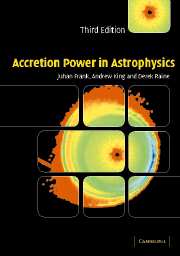Book contents
- Frontmatter
- Contents
- Preface to the first edition
- Preface to the second edition
- Preface to the third edition
- 1 ACCRETION AS A SOURCE OF ENERGY
- 2 GAS DYNAMICS
- 3 PLASMA CONCEPTS
- 4 ACCRETION IN BINARY SYSTEMS
- 5 ACCRETION DISCS
- 6 ACCRETION ON TO A COMPACT OBJECT
- 7 ACTIVE GALACTIC NUCLEI
- 8 ACCRETION DISCS IN ACTIVE GALACTIC NUCLEI
- 9 ACCRETION POWER IN ACTIVE GALACTIC NUCLEI
- 10 THICK DISCS
- 11 ACCRETION FLOWS
- Appendix: Radiation processes
- Problems
- Bibliography
- Index
9 - ACCRETION POWER IN ACTIVE GALACTIC NUCLEI
Published online by Cambridge University Press: 05 June 2012
- Frontmatter
- Contents
- Preface to the first edition
- Preface to the second edition
- Preface to the third edition
- 1 ACCRETION AS A SOURCE OF ENERGY
- 2 GAS DYNAMICS
- 3 PLASMA CONCEPTS
- 4 ACCRETION IN BINARY SYSTEMS
- 5 ACCRETION DISCS
- 6 ACCRETION ON TO A COMPACT OBJECT
- 7 ACTIVE GALACTIC NUCLEI
- 8 ACCRETION DISCS IN ACTIVE GALACTIC NUCLEI
- 9 ACCRETION POWER IN ACTIVE GALACTIC NUCLEI
- 10 THICK DISCS
- 11 ACCRETION FLOWS
- Appendix: Radiation processes
- Problems
- Bibliography
- Index
Summary
Introduction
In these final three chapters we come to the mechanism by which the gravitational potential energy of material accreting on to a superrnassive black hole is extracted as radiation. We start with the radio emission on kpc–Mpc scales which, where it occurs, is probably the best understood feature. To power the extended radio lobes the central engine in sources with such large-scale radio structure must turn accretion energy into directed bulk relativistic outflow. It is universally accepted that the power law radio spectrum from the lobes is synchrotron radiation from relativistic electrons. At the other extreme the X-ray emission appears to be produced on scales down to tens of Schwarzschild radii, providing the deepest possible probe of conditions near the black hole. However, the X-ray power law spectrum seems to admit any number of explanations. There is a problem here in distinguishing the primary radiation from any reprocessed components.
Since, therefore, we are not certain of either the geometry of the central source or the emission mechanism responsible for any part of the spectrum from this region, a discussion of accretion power in active nuclei contrasts sharply with our previous consideration of binary star systems. We shall present a range of partial theories each focussed on a different aspect of the problem. The thick discs expected at super- Eddington accretion rates to be considered in Chapter 10, and the electrodynamic disc theories discussed here in Sections 9.6–9.8 are primarily concerned with the production of power in the form of bulk relativistic outflows.
- Type
- Chapter
- Information
- Accretion Power in Astrophysics , pp. 267 - 295Publisher: Cambridge University PressPrint publication year: 2002
- 1
- Cited by



